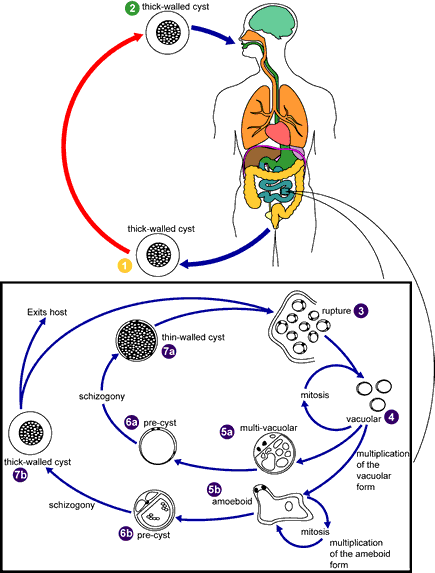
Knowledge of the life
cycle and transmission is still under investigation, therefore this is a
proposed life cycle for B. hominis. The classic form found in human
stools is the cyst, which varies tremendously in size from 6 to 40 μm
![]() .
The thick-walled cyst present in the stools
.
The thick-walled cyst present in the stools
![]() is believed to be responsible for external transmission, possibly by the
fecal-oral route through ingestion of contaminated water or food
is believed to be responsible for external transmission, possibly by the
fecal-oral route through ingestion of contaminated water or food
![]() . The
cysts infect epithelial cells of the digestive tract and multiply asexually
(
. The
cysts infect epithelial cells of the digestive tract and multiply asexually
(![]() ,
,
![]() ).
Vacuolar forms of the parasite give origin to multi vacuolar
).
Vacuolar forms of the parasite give origin to multi vacuolar
![]() and
ameboid
and
ameboid ![]() forms. The multi-vacuolar develops into a pre-cyst
forms. The multi-vacuolar develops into a pre-cyst
![]() that
gives origin to a thin-walled cyst
that
gives origin to a thin-walled cyst
![]() ,
thought to be responsible for autoinfection. The ameboid form gives origin
to a pre-cyst
,
thought to be responsible for autoinfection. The ameboid form gives origin
to a pre-cyst
![]() , which
develops into thick-walled cyst by schizogony
, which
develops into thick-walled cyst by schizogony
![]() . The
thick-walled cyst is excreted in feces
. The
thick-walled cyst is excreted in feces
![]() .
.